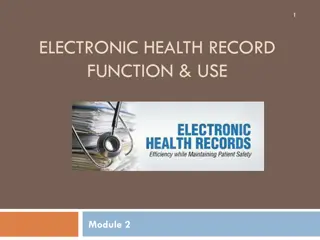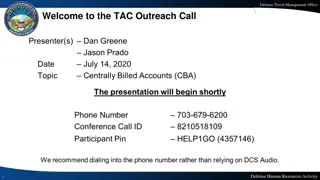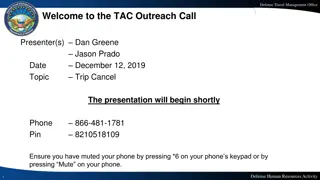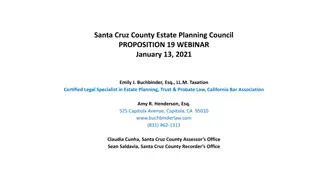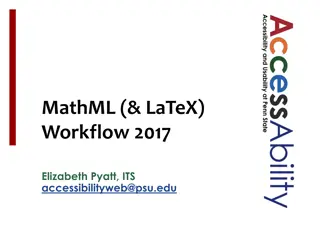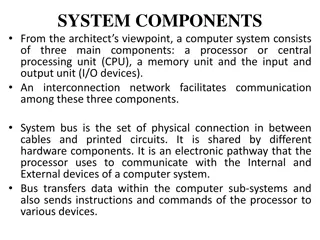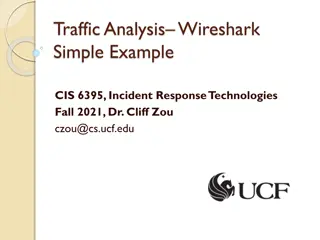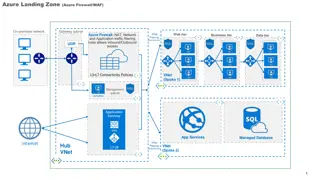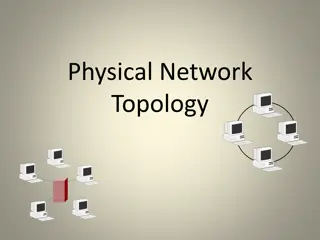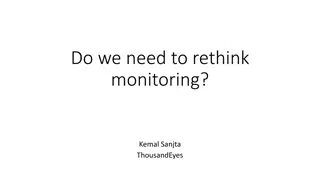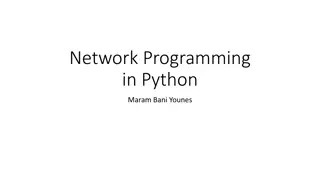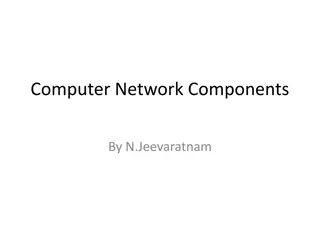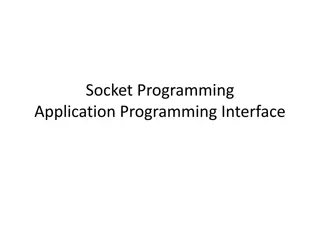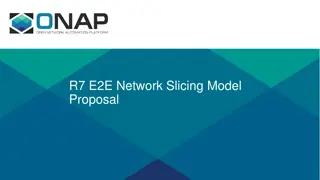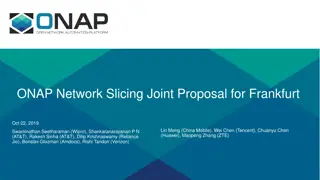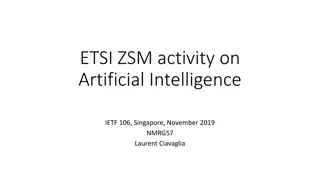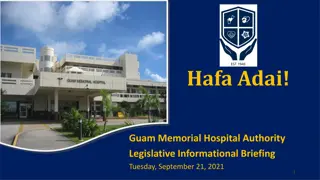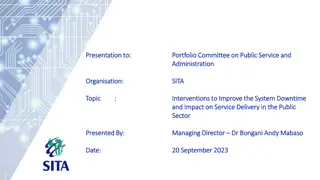FHCC Workarounds Within a Two-Network/EHR System
This document outlines workarounds implemented within a two-network/two-EHR system as of January 14, 2020, for internal use by the DoD and VA. It covers areas such as general clinical operations, laboratory processes, pharmacy, consultations, referrals, and imaging/radiology. Various challenges and their corresponding solutions are discussed, including issues related to patient registration, application access, data accuracy, and laboratory orders portability. Workarounds are provided to address inefficiencies, delays, and communication gaps encountered in this complex healthcare environment.
Download Presentation

Please find below an Image/Link to download the presentation.
The content on the website is provided AS IS for your information and personal use only. It may not be sold, licensed, or shared on other websites without obtaining consent from the author. Download presentation by click this link. If you encounter any issues during the download, it is possible that the publisher has removed the file from their server.
E N D
Presentation Transcript
FHCC Workarounds within a Two Network/Two EHR System January 14, 2020 DoD and VA Internal Use Only
Overview of Workarounds General Clinical Laboratory Pharmacy Consult/Referrals Imaging/Radiology 2 DoD and VA Internal Use Only
General Clinical Workarounds Registration of FHCC Patients: orders portability requires a correlated patient the crossing of orders from East to West campus [ = workload capture] requires a correlated patient some beneficiaries are unaware of the need to jointly register into VA (MVI) and DoD (DMDC) Workaround: provider calls registration office to confirm; at check-in, clinic may need to send patients to registration office to get properly registered downstream delays in care (domino effect) extra staff training Lack of Industry Standard Immediate and Consistent Access to Clinical Applications Uncoordinated agency-specific downtimes/updates/maintenance unplanned application unavailability two EHRs traversing a firewall between two East & West Campus networks results in variable application latency Workarounds: Application Virtualization Hosting Environment (AVHE) = significant delays (4 minutes+) in opening clinical applications Paper prescriptions: ED Joint Legacy Viewer (JLV) is not the optimal solution latency issues requires providers to correctly interpret UTC/Zulu collecting/resulting times for lab results [Pt Safety/Added Work] lack of diagnostic quality images, ECGs, etc. Provider reluctance to learn both EHR systems exacerbated by lack of Medical Single Sign-on with Context Management missed opportunities for better patient care and outcomes ineffective communication of important news clinical application lockouts due to provider inaction or forgetfulness password expired or never created delays in patient care forget to sign in to both systems at least once a month Workaround: resulting inefficiencies borne by support staff [Pt Safety/Added Work] Questionable Accuracy of Data Quality Reports Questionable data accuracy for data quality reports to DHA/VACO, e.g., a1c Workaround: labor-intensive manual extraction/explanation of data otherwise immediately available within peer MTF s/VAMC s [Pt Safety/Added Work] 3 DoD and VA Internal Use Only
Laboratory Workarounds Orders portability (OP) issues: requires correlated patient Processing labs drawn from East Campus Clinics (Navy Recruits/TRICARE patients) Workaround: when samples sent from East Campus lab are received by the main West Campus lab, processing is delayed while checking to ensure that all East Campus CHCS lab orders crossed into VistA via orders portability; only then can the lab techs print VA VistA labels onto the specimens [Pt Safety/Added Work] If samples are not checked but put on the Streamlab, they get fielded into the storage module and are lost the samples become un-retrievable Reliability of results crossing from VistA into CHCS Workaround: providers often come to the lab to ask for the status of results lab staff investigate to determine if test was completed needless delays in care [Pt Safety/Added Work] Time stamp confusion if orders portability goes down When results are entered manually or retransmitted by the Orders Portability staff, the tech who verified the test result and the time resulted are different from the original result. Workaround: for manually entered results, canned comments are entered showing the original resulting tech and the original time of verification. However, when results have to be retransmitted (in batches), the original verifier is displayed but not the original time [Pt Safety/Added Work] Unforeseen consequences of orders entered incorrectly In Aug 2019, a system wide outage due to an improperly placed regenerating histology order server had to be shut down Workaround: for a 2-day period, all available orders and accessions had to be retransmitted with results entered manually [Pt Safety/Added Work] 4 DoD and VA Internal Use Only
Laboratory Workarounds Accessioning Issues Tests that are run on East Campus BUT collected on West Campus must be accessioned in CHCS. This affects the AD HIV and CT/NG that are run at Branch Health Clinic 1523. If these tests are accessioned in VistA, they go to pending status under BHC 1523. This causes multiple processing and accountability problems [Pt Safety/Added Work] Resulting panel tests that include multiple accessions creates issues in CHCS If certain protocols require that one of the panel accessions needs to be cancelled, CHCS will not allow this. Workaround: the accessions are sent to the main lab on West Campus so they can be accepted and cancelled in VistA [Added Work] Microbiology culture results fail to transmit from VistA to CHCS due to errors (unresolvable legacy bug in the microbiology package) Workaround: enter the results manually. Labor intensive and also changes the result format in CPRS looks confusing to providers [Pt Safety/Added Work] Uncoordinated VA/DoD software updates affect synchronization of available functionalities AHLTA/CHCS updates less frequently than CPRS/VistA. To ensure that East Campus/West Campus providers can order the same test at the same time (if it is a new test), the below workaround is used Workaround: the Laboratory Information Manager must wait for the next scheduled update time when mapping is to take place to make the change, or the change is made knowing it is not going to be the same in both systems. A testing workaround is next done until the change is the same in both systems [Pt Safety/Added Work] Creating new tests requested by providers specifically for a reference lab this is a challenge because VistA and CHCS each have unique criteria to accomplish this Workaround: none currently available [Missed opportunity for better patient outcome] 5 DoD and VA Internal Use Only
Laboratory Workarounds Tracking of Specimens 1. LabLion does not recognize orders placed in CHCS, only CPRS. Therefore, cannot track specimens collected on the East Campus. If specimens do not get submitted to the main West Campus lab, we will not know until a provider calls seeking results Workaround: East Campus providers are asked to order their labs using CPRS. However, East Campus providers won t/can t order in CPRS due to learning curve and/or inconvenience of shutting down their familiar AHLTA/CHCS applications to try to start CPRS [Pt Safety/Added Work] 2. Pending specimen ADHOC reports can only be generated in CHCS. If CHCS goes down, we won t know if there are any specimens not submitted to the lab. If orders portability goes down, the specimen will remain pending in CHCS until everything is synchronized again Workaround: for sending out PAPs/HPVs to a reference lab is to order and result everything manually. Reference labs cannot automatically transmit results into our VistA Anatomic Pathology package; therefore, everything is entered and signed out manually. When the case is signed out manually, a pathologist must be assigned, so turnaround times and statistics must be manually calculated as well [Pt Safety/Added Work] Workaround: If PAPs/HPVs are ordered on the West Campus to be sent to Naval Medical Center Portsmouth, the orders need to be cancelled and reordered manually using CHCS prior to sending it out [Pt Safety/Added Work] 6 DoD and VA Internal Use Only
Pharmacy Workarounds No Orders Portability No Allergies Portability Must check both systems for each patient to avoid missing orders Workaround: toggle between a two systems set up [Pt Safety/Added Work] Allergy data not synchronized in both systems For dual eligible patients, allergy list may not be synchronized in both systems don t get duplicate therapy warnings patient could get the same Rx in both systems without triggering a warning Workaround: manually checking both systems [Pt Safety/Added Work] Provider reluctance to learn how to use both systems E.g., instead of learning CHCS, easier to give TRICARE patients handwritten prescriptions prevents automated order checks increased unnecessary workload for pharmacy staff legibility errors [Pt Safety/ Added Work] Workaround: pharmacy staff manually processes what should be automated prescription processes [Pt Safety/Added Work] Training new and current staff to use two EHRs [Added Work] 7 DoD and VA Internal Use Only
Consult/Referral Management Workarounds Rate-limiting Step: Joint Registration Correlated Patient Work space: West Campus using VA Desktop Ordering consults for Procedures & Non-Formulary Items = challenging Workarounds: Front-end: providers must appropriately and accurately enter prescriptions and consults and know which is the correct system to use (steep learning curve) [Pt Safety] [Added Work] Back-end: labor-intensive creation of new consult titles by administrative staff involves navigating two systems and two policies (MISSION ACT, TRICARE) [Added Work] Orders portability glitches : Specialty referrals (e.g., Cardiology) to Referral Management Center (RMC) sometimes do not cross over from CPRS to CHCS delay in care. Workaround: place RMC as view alerts in CPRS so providers are notified if the referral order doesn t reach the Utilization Management queue in CHCS [Pt Safety] [Added Work] Unreliability of automated referral tracking: cannot rely on RMC referrals populating the referral tracking software (Carepoint RMS) every hour. Workaround: constant vigilance; manually push from CHCS to RMS to ensure referral order gets into Carepoint Humana Military Portal (Managed Care Support Contractor) [Pt Safety] [Added Work] 8 DoD and VA Internal Use Only
Consult/Referral Management Workarounds Problems Identifying the ordering provider (interoperability workarounds due to policies having FHCC Specialty Care clinics use CPRS/VistA while DoD Primary Care clinics use AHLTA/CHCS) When CPRS orders push to CHCS, the ordering provider is listed as PROXY PROVIDER difficult to track down ordering provider if questions arise requires a lot of toggling between CPRS and AHLTA takes significant time (average two minutes) to open AHLTA via AVHE [Pt Safety] [Added Work] Proxy Provider status is invoked if a provider doesn t have an active account in both EHRs test results relayed to whom? Workarounds: call coworkers who may be successfully logged in to AHLTA and ask them to pull the required data to address issues in timely manner [Added Work] walk 0.25 miles to the basement of FHCC Building 134 and log in to the computer having a DHA Desktop; seems faster than waiting to repeatedly attempt to log in to AHLTA via AVHE [Added Work] Problems Determining Beneficiary Status dual eligibility When using CPRS, it is sometimes unclear if a patient is a DoD or VA beneficiary. Sometimes they have dual eligibility but sometimes it is entered incorrectly. This database is only as good as the most recent manual entry and its proper interface and data transfer with DEERS Workaround: log in to the Humana portal to check patient eligibility. The managed care support contract (MCSC) is more reliable on their DEERS data than FHCC s CPRS/VistA database [Added Work] TRICARE s Clear and Legible Reports (CLRs) attached to non-MTF consults Workaround: we previously were able to scan CLRs directly into HAIMS. Now, must be scanned into the user s desktop, saved as a file, and then uploaded via a BROWSE feature. Labor-intensive workaround: the PII must be saved on the computer, staff have to remember to delete it, and probability for human error is increased when multiple patient scans are an option during uploads [Pt Safety] [Added Work] 9 DoD and VA Internal Use Only
Imaging/Radiology Yes: Orders Portability No: Images Portability Ease of Viewing Images and Scanned Documents different between campuses Workaround: East Campus providers have to close down AHLTA/CHCS (losing significant momentum) and open CPRS to gain access to ECGs, scanned documents and radiologic images; it may require more time to re-open AHLTA depending on time of day delays in care [Pt Safety] [Added Work] Lack of Images Portability (orders cross over, images don t) radiology images don t cross into other agency s PACS due to program language incompatibility Workaround: find appropriate workstation to view images, usually involves walking long distances [Pt Safety] [Added Work] Appointment scheduling unnecessarily difficult CHCS menus not optimal (in relation to CPRS); steep learning curve Workaround: manual tracking [Added Work] Provider reluctance to learn how to use both systems Workaround: instead of learning CHCS and CPRS, easier to use home agency s system variation in imaging ordering suboptimal communication of important patient data [Pt Safety] [Added Work] 10 DoD and VA Internal Use Only
Lingering Questions Concerns about Cerner Millennium/MHS Genesis operating within two networks (VA and DoD MEDCOI) what are the true effects of firewall (Palo Alto) on speed of accessing clinical/business applications across two networks? continued use of AVHE (= applications access delays) needed? will Cerner eliminate need to maintain orders portability functionalities? Unknown interdependencies: FHCC VISN 12 DHA will Cerner operationally be better for FHCC (and VISN12 & DHA) versus continued implementation of current capabilities and workarounds? Truly One Cerner? will FHCC s one Cerner be able to easily extract accurately translated and computable data from Cerner s central data center when called upon to satisfy DHA/VACO within industry standards? Proof? 11 DoD and VA Internal Use Only
JAL FHCC Top 10 Functional Enhancements List Capability POC Description Tracey Isom To have a Reliable indicator (Green Check Mark) in Joint Registration that affirms the patient s VistA/MVI and CHCS/DEERS records are linked Ensure and enhance the HL7 message transmissions for CPRS Anatomic Pathology orders and VistA accessioning message traffic *PS Ability to retransmit failed cytology/surgical pathology reports via the Retry GUI Tool Ability for Progress Notes in computer patient records (CPRs) and Encounters in AHLTA to cross between systems via ORP *PS Defect Repairs Category 1 1. Joint Patient Registration 6. Laboratory - Radiology Janki Patel, Nirali Patel, Edwin Zaptana Janki Patel, Nirali Patel Yvette Batie Rhonda Paulson 7. Laboratory 2. Progress Notes and Encounters - Outside of Baseline Requirements 3. Allergy Portability - Outside of Baseline Requirements 4. Orders Portability Sherri Stoecklein, Kathy Gluzinski Yvette Batie Rhonda Paulson Sherri Stoecklein, Kathy Gluzinski Allergy Portability: Real Time Synchronization of DoD and VA patient allergy information *PS Failsafe: Each system (VistA/CHCS, or respective ESBs) must determine validity/accuracy of outbound Lab/Rad/Consult messages *PS Per the JAL FHCC Informatics Report, the site "desires a Pharmacy ORP solution to be developed *PS New Enhancements Category 2 5. Consults -Pharmacy 8. Outside of Baseline Requirements 10. Financial Management Norman Lee Outpatient Appointing- Per JAL FHCC Informatics Report, implementing a joint outpatient appointment scheduling capability is recommended *PS Desire to have Financial Management Tool re-designed to allow timely upload of DoD workload files and automated approval and validation Veronica J. Gabriel Dwayne Meeker Theodore M Jaditz Yvette Batie Rhonda Paulson Further Analysis 9. Other Identified Needs Currently if provider does not maintain active accounts in both medical records, the order crosses with no provider attached to the order (invoking proxy provider). Delay in notification of critical/abnormal results to the provider *PS Category 3 DoD and VA Internal Use Only *PS: Patient Safety


